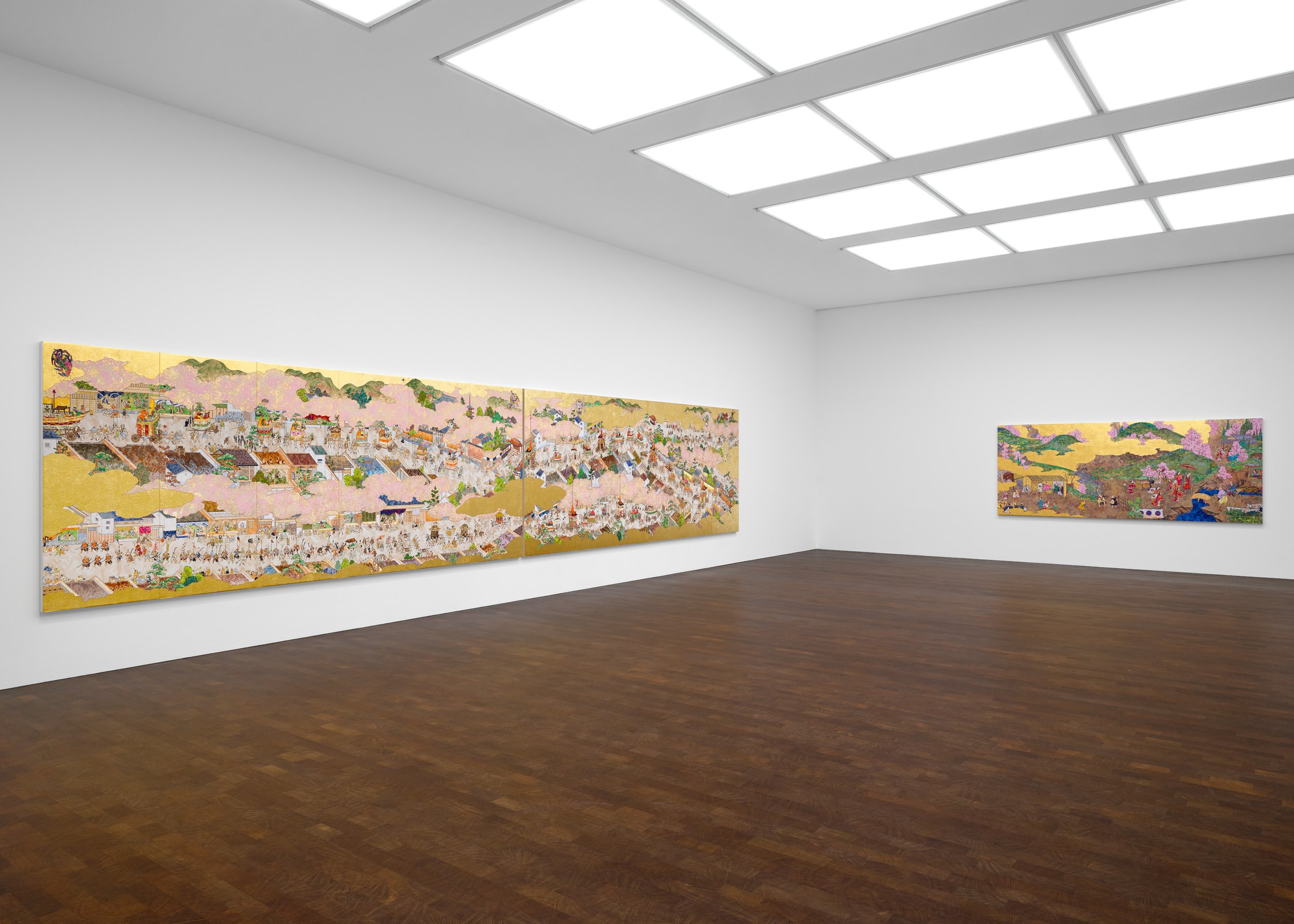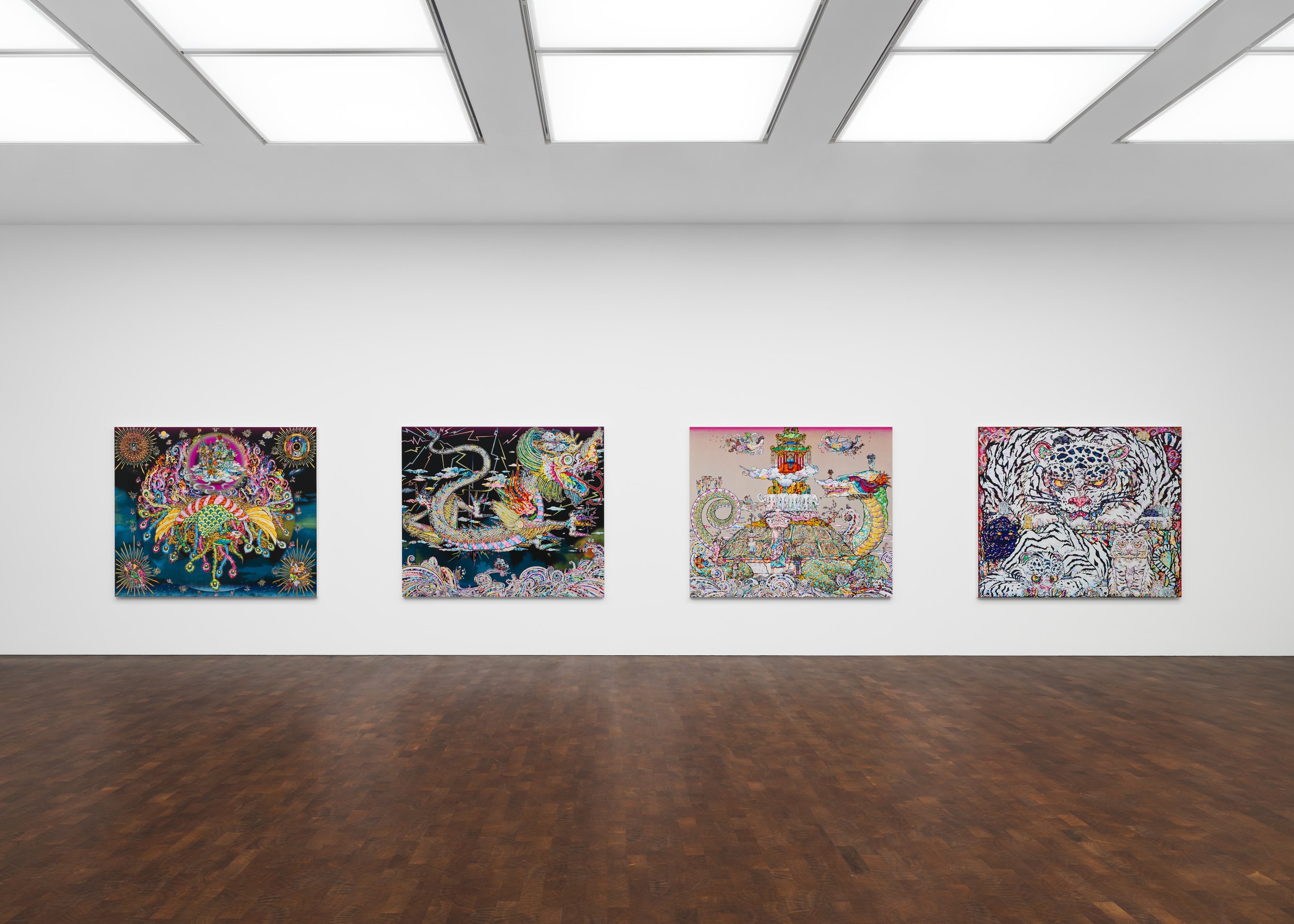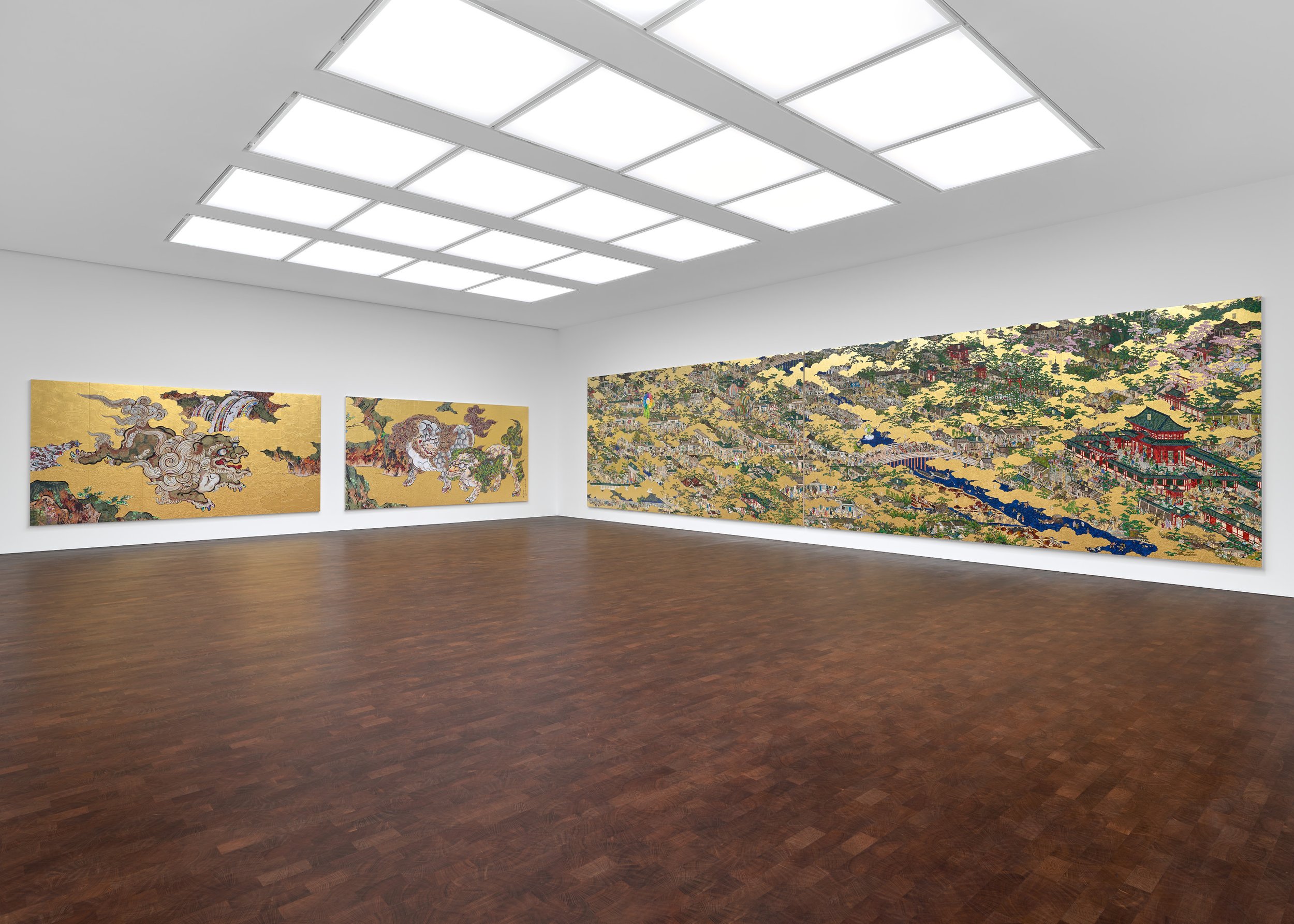Takashi Murakami: Japanese Art History à la Takashi Murakami



Takashi Murakami: Japanese Art History à la Takashi Murakami, 2024–2025 installation view Artwork © 2024 Takashi Murakami/Kaikai Kiki Co., Ltd. All Rights Reserved Photo: Prudence Cuming Associates Ltd Courtesy Gagosian
LONDON,—Gagosian is pleased to announce Japanese Art History à la Takashi Murakami, an exhibition of new paintings by Murakami at its Grosvenor Hill gallery in London. In this presentation, the artist pursues his fascination with the narrative of Japanese art by offering his own interpretations of historical paintings. By “Murakamizing” these iconic images, he ponders the erosion of the nation’s ancient splendor; he also considers the ways in which it has been impacted by new aesthetics and values associated with its opening to the West after the end of the Edo period (1603–1868)
Takashi Murakami White Tiger and Family, 2024 Acrylic on canvas mounted on aluminum frame 70 7/8 x 84 5/16 inches (180 x 214.1 cm) © 2024 Takashi Murakami/Kaikai Kiki Co., Ltd. All Rights Reserved. Photo: Kei Okano Courtesy Gagosian
Rakuchu¯-Rakugai-zu Byo¯bu: Iwasa Matabei RIP (2023–24) is modeled on Iwasa Matabei’s Rakuchu¯- Rakugai-zu Byo¯bu (Scenes in and around Kyoto) (Funaki Version) from the collection of the Tokyo National Museum. The original seventeenth-century work depicts the city in extraordinary detail across two six-panel folding screens. Murakami’s version, which was commissioned for his exhibition Mononoke Kyoto at the Kyoto City Kyocera Museum of Art, populates its gold-leaf clouds with skulls, a memento mori inspired by a visit to the Toribeno burial ground. He also integrates examples of his own iconography including smiling flower-faced figures and his familiar Mr. DOB character.
Takashi Murakami Black Tortoise and Arhats, 2024 Acrylic on canvas mounted on aluminum frame 70 7/8 x 84 5/16 inches (180 x 214.1 cm) © 2024 Takashi Murakami/Kaikai Kiki Co., Ltd. All Rights Reserved. Photo: Kei Okano Courtesy Gagosian
Murakami’s paintings of the Four Symbols, mythical guardians of Kyoto, pair each of their subjects with metropolitan locations aligned with the four compass directions: the Black Tortoise is associated with Mount Funaoka and Mount Kitayama in the north of the city; the Blue Dragon with the Kamo River in the east; the Vermillion Bird with Ogura Pond in the south; and the White Tiger with the San’indo Highway in the west. To arrive at these juxtapositions, Murakami combined his own sketches with AI-generated images and fragments of his earlier works in a process that parallels the inventiveness of earlier artists in depicting unfamiliar or imaginary creatures. Another diptych pictures the gods of wind and thunder in the blend of classical Japanese painting techniques with Pop, anime, and otaku graphics that Murakami terms “Superflat.” This paired depiction employs the same motifs and composition that Tawaraya So ˉtatsu (c. 1570–c. 1640), Ogata Ko ˉrin (1658–1716), and Sakai Ho ˉitsu (1761–1828) each revisited roughly a century apart. At the same time, it allows viewers to observe the development of the Kyoto-based Rinpa school. In the premodern artists’ paintings, the subjects are depicted as Buddhist deities or attendants; today, they sometimes even appear on commercial packaging in the form of cartoonlike icons, a transformation reflected in Murakami’s treatment.
Takashi Murakami Rakuchū-Rakugai-zu Byōbu: Iwasa Matabei RIP, 2023–24 (detail) Acrylic and gold leaf on canvas mounted on wood panel, in 2 parts Overall: 9 feet 10 ⅛ inches × 42 feet 10 ⅞ inches (3 × 13.1 m) © 2023-2024 Takashi Murakami/Kaikai Kiki Co., Ltd. All Rights Reserved Photo: Joshua White Courtesy Gagosian
Among the other works in the exhibition are figure and flower paintings, including a tondo. In one, Murakami reworks a set of Daigo Hanami-zu screens from the collection of the National Museum of Japanese History in Sakura that depicts a cherry blossom viewing event on the grounds of Kyoto’s Daigoji Temple; in another, he reinterprets a pair of Kiku-zu screens by Ko ˉrin that portray chrysanthemums in white, green, black, and gold. A version of an additional screen by the same artist features bunches of hollyhocks in red, pink, and white, while a work inspired by a screen from the collection of the Artizon Museum, Tokyo, reproduces a composition of hollyhocks and peacocks. The\ tondo features aqueous patterns, or “Ko ˉrin Water,” and repeating chrysanthemums, motifs developed by Ko ˉrin that sometimes also appear on kimono fabric. In this bridging of art and fashion, Ko ˉrin, who was the son of a kimono merchant, could be considered Murakami’s creative forerunner.
Takashi Murakami Golden Pavilion, 2024 Acrylic on canvas mounted on wood panel 32 3/8 x 26 inches (82.2 x 66.1 cm) © 2024 Takashi Murakami/Kaikai Kiki Co., Ltd. All Rights Reserved Photo: Kei Okano Courtesy Gagosian
A limited number of copies of Takashi Murakami: An Arrow through History, a new catalogue documenting the 2022 exhibition of the same title at Gagosian New York, which comes with a trading card designed by the artist, will be available at the gallery.
Also opening on December 10, and on view concurrently with the exhibition, Murakami is taking over Gagosian Burlington Arcade. Four new paintings featuring the artist’s smiling flowers are on view in the gallery, while the Shop offers prints and merchandise.
Takashi Murakami Re: "Daigo-Hanami-zu-Byōbu", 2024 Acrylic and gold leaf on canvas mounted on wood panel 59 1/8 x 142 inches (150 x 360.5 cm) © 2024 Takashi Murakami/Kaikai Kiki Co., Ltd. All Rights Reserved Photo: Kei Okano Courtesy Gagosian
The artist was in conversation with Hans Ulrich Obrist at 4pm on Wednesday, December 11, at the Benjamin West Lecture Theatre at the Royal Academy of Arts, London. The pair discussed Murakami’s interpretation of ancient Japanese art, including his reworking of Matabei’s Rakuchu¯- Rakugai-zu and the Rinpa school.
Takashi Murakami was born in Tokyo, where he lives and works. Collections include the Museum of Modern Art, New York; Museum of Fine Arts, Boston; Museum of Contemporary Art, Chicago; Museum of Contemporary Art, Los Angeles; the Broad, Los Angeles; San Francisco Museum of Modern Art; and 21st Century Museum of Contemporary Art, Kanazawa, Japan. Exhibitions include Murakami Versailles, Château de Versailles, France (2010); Murakami: The 500 Arhats, Mori Art Museum, Tokyo (2015); Murakami by Murakami, Astrup Fearnley Museet, Oslo (2017); The Deep End of the Universe, Albright-Knox Art Gallery, Buffalo, NY (2017); Under the Radiation Falls, Garage Museum of Contemporary Art, Moscow (2017); The Octopus Eats Its Own Leg, Museum of Contemporary Art, Chicago (2017, traveled to Vancouver Art Gallery, Canada, and Modern Art Museum of Fort Worth, Texas, in 2018); Murakami vs. Murakami, Tai Kwun Contemporary, Hong Kong (2019); MurakamiZombie, Busan Museum of Art, South Korea (2023); Mononoke Kyoto, Kyoto City Kyocera Museum of Art, Japan (2024); and Hiroshige’s 100 Famous Views of Edo (feat. Takashi Murakami), Brooklyn Museum, New York (2024).
#TakashiMurakami
The exhibition opened on December 10, 2024 and will be on view until March 8, 2025 There was an opening reception at the London location on Tuesday, December 10 from 6 to 8pm.
For more information about this exhibition and others presented by Gagosian please visit the gallery’s site here. The gallery can also be found on Pinterest, X, YouTube, Facebook, Instagram, and Artsy.




